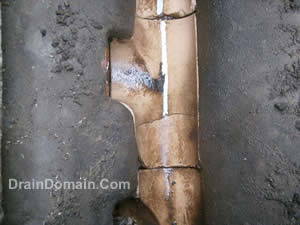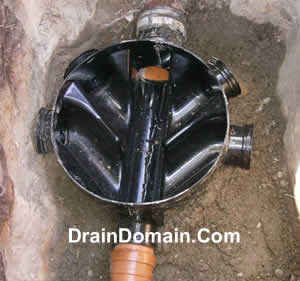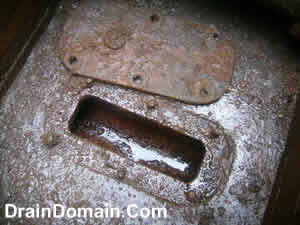Manhole Channel Pipes
 These are the half pipes found in the base of manhole that allow access into the incoming and out going pipe work, simple enough you would think but as with anything there is a correct way of installing them and an incorrect way. These are the half pipes found in the base of manhole that allow access into the incoming and out going pipe work, simple enough you would think but as with anything there is a correct way of installing them and an incorrect way.
Clay Channel Pipes
Bends, junctions and pipes are all available in channel form and the clay version should be bedded on a mortar or concrete base with the joints between them and the incoming and out going pipe work being sealed with sand and cement, the sand and cement benching is then formed up to the channels making the chamber base a solid and water tight unit.
Typical Defects On Clay Channel Pipes
The weak point is usually the joints as a weak or poorly installed mix of mortar can wash out, this leads to water loss and erosion of the chamber sub-base, tree root and ground water ingress are also common through poorly sealed joints. A poorly bedded channel pipe is also prone to fracturing when your drain man drops the manhole cover, his torch, his flask or all three into the chamber.
Other defects are usually down to poor installation such as a lack of fall through the chamber or using a square junction instead of an oblique junction on foul connections.
 Plastic Channel Pipes Plastic Channel Pipes
Not so common these days thankfully as they were a pain to seal and getting mortar to adhere to plastic is not the easiest of jobs. These days we tend to install full plastic manhole bases and they are available in numerous configurations whether its a left hand bend, a 150mm channel with two 100mm branch lines or a straight channel pipe running through the chamber, other benefits with these chamber bases are that they are a one piece mould so no root or water ingress and the benching is already formed for you so no build up of waste in the chamber (in most cases).
Cutting Full Pipe Work Into Channels
Its not uncommon for builders, DIYers and as it happens drain men to use full pipes in the base of a chamber during its construction and then after it has been benched to cut out the top of the pipe and create their own channel pipes, this can work if done correctly but unfortunately it seldom is. If it is a straight pipe running through the manhole it should be simple enough if indeed the final cutting of the pipe is ever undertaken, its not uncommon to lift a manhole cover and find yourself staring at a full pipe running through it.
The problems start when you have bends and junctions in the base as when you push your full plastic or clay pipe work together the water tight seal comes from the rubber sealing ring sat in the collar or coupling, if you in affect remove the top half of that sealing ring when you cut out the crown of the pipe to make your channel the water tight seal has gone.
The other downside of making your own channel pipes is only really noted by contractors, clay pipes in particular are savage when cut incorrectly and they will take chunks out of jetting hoses and push rod camera cables shortening their life span considerably.
Cast Iron Channel Pipes
 Usually found in city centre basements or within schools and colleges cast iron systems almost always have bolted down sealing plates over the channels, which in affect make the channel into a full pipe (if you follow me). Usually found in city centre basements or within schools and colleges cast iron systems almost always have bolted down sealing plates over the channels, which in affect make the channel into a full pipe (if you follow me).
This offers at least two problems, the first is that cast iron pipe work corrodes over the years and the sealing plate and its bolts fuse to the main pipe work. the other being that if the system is blocked and you have to get into a chamber to unscrew a sealing plate the only thing between you and a large amount of bubbling sewage is the said plate. So if you unscrew the bolts and lift the plate Bingo, your up to your knees in sewage and you have ruined your wellies.
Repairing Fractured Or Broken Channel Pipes
If the mortar in the joints has washed out they can be re-pointed but you will need to remove as much moisture as possible from the joints and obviously stop any flow, there are several additives on the market to aid fast curing of the sand and cement mix.
We have also had success in sealing broken and fractured channels using drain lining techniques, same procedure as drain lining but you either form a channel pipe or cut out the crown of the liner after it has cured.
If their is enough room in a chamber you can break or cut out the channel and drop in a new section before making good the joints and benching, if there's not enough room it is sometimes necessary to dismantle the chamber and rebuild it.
|

 These are the half pipes found in the base of manhole that allow access into the incoming and out going pipe work, simple enough you would think but as with anything there is a correct way of installing them and an incorrect way.
These are the half pipes found in the base of manhole that allow access into the incoming and out going pipe work, simple enough you would think but as with anything there is a correct way of installing them and an incorrect way. Plastic Channel Pipes
Plastic Channel Pipes  Usually found in city centre basements or within schools and colleges cast iron systems almost always have bolted down sealing plates over the channels, which in affect make the channel into a full pipe (if you follow me).
Usually found in city centre basements or within schools and colleges cast iron systems almost always have bolted down sealing plates over the channels, which in affect make the channel into a full pipe (if you follow me).
